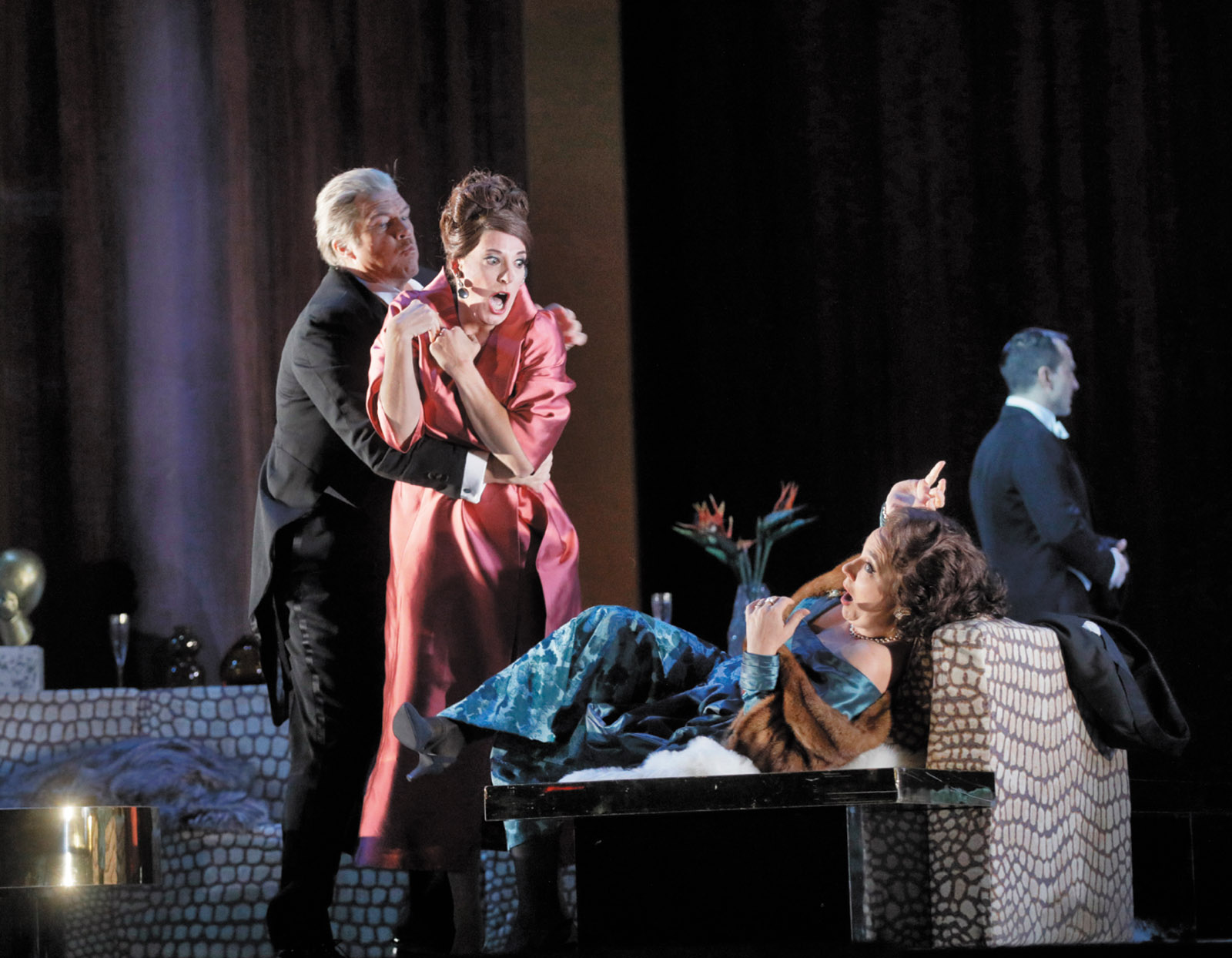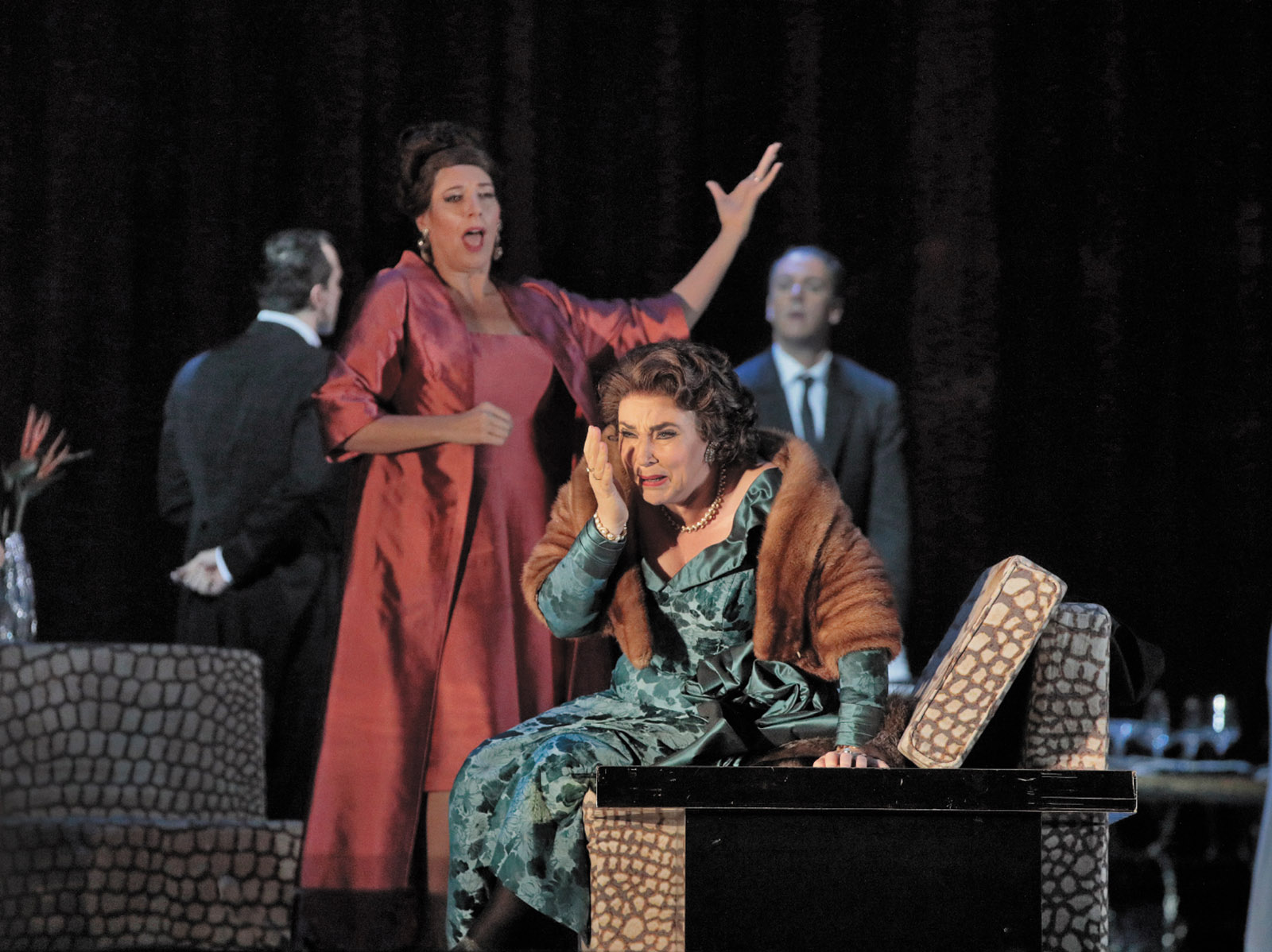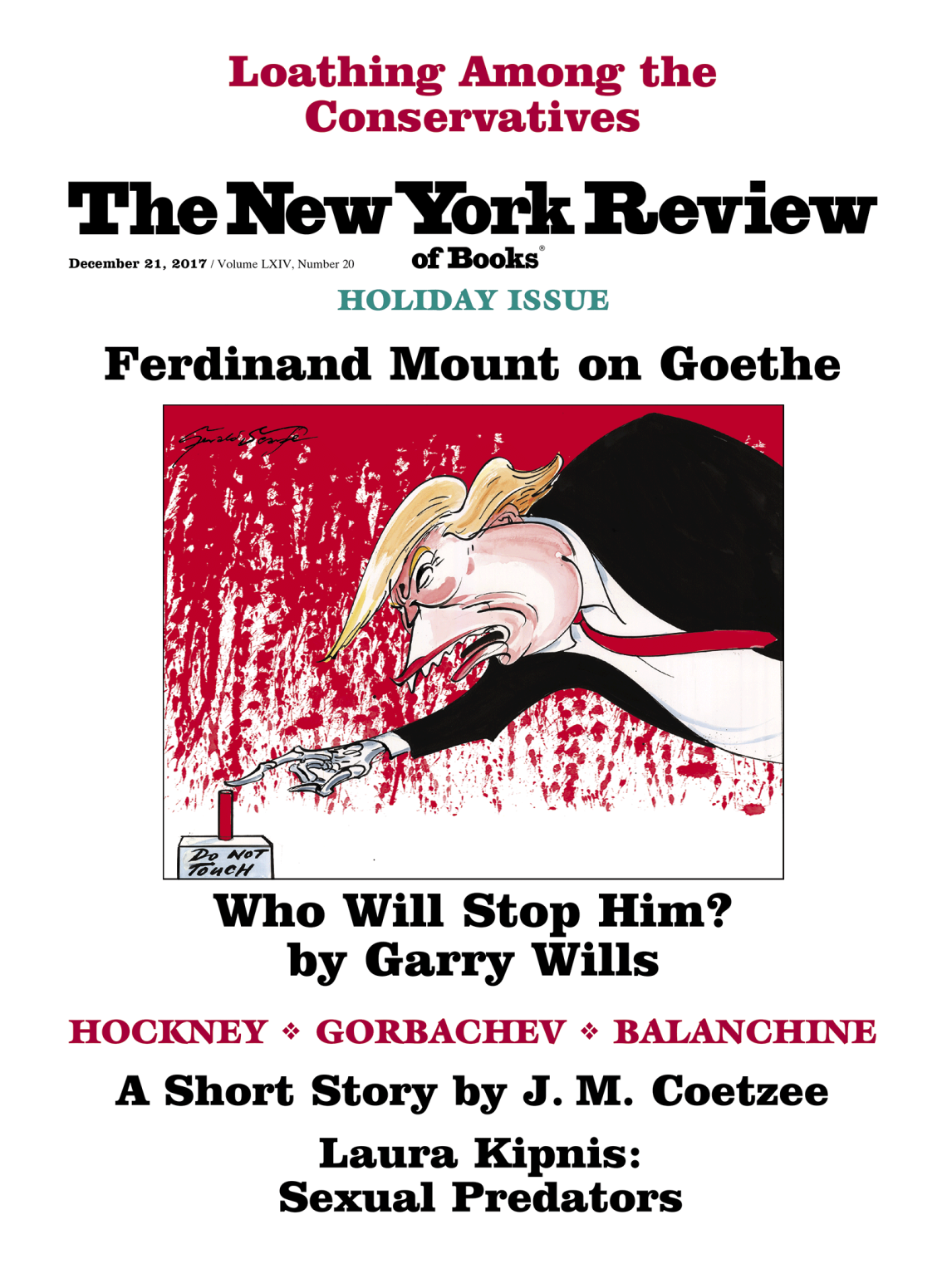“People go to a dinner party and for some reason they can’t leave,” a Met patron was explaining to his companion as we waited in the lobby for the doors to open for Thomas Adès’s new opera, The Exterminating Angel. Of all plots it must be the easiest to recap. The genius of the premise of Luis Buñuel’s 1962 Mexican film was to strip narrative down to an irreducible stasis: for no knowable cause, a group of people are unable to move forward. The more particular genius of its execution was to make this play like a real story rather than an exercise in absurdist abstraction. No matter how many times you watch it—each time becoming more aware of the contradictions, repetitions, and anomalies that constantly eat away at its semblance of logic—you nevertheless are drawn into an anticipation that this time, somehow, a different way will be found, a different outcome made possible: all this concern for as socially callous and uselessly self-absorbed a collection of upper-class twits and jaded neurotics as could be imagined.
Buñuel’s dinner guests, who arrive (twice, as an early warning of impending discontinuities) at the home of Edmundo and Lucía de Nobile to honor an opera singer who has just performed Lucia di Lammermoor, barely qualify as characters. They are masks, types—the Aristocrat, the Military Man, the Artiste, the Doctor, the Invalid, the Lovers—made even more generic by a style of acting redolent of the kind of commercial melodrama that some of the cast customarily appeared in. It is only as these waxwork figures start to fall apart—in a process that will lead to quarrels, hysteria, sexual molestation, suicide, animal sacrifice, hallucinations, rites of exorcism, and a nearly successful initiative to lynch the host—that they seem human at all. Only a last-minute (and temporary) miracle allows them to reassume the roles they walked in with, liberated from their incarceration in the mansion on Calle de la Providencia as mysteriously as they were imprisoned.
Why Thomas Adès should settle on this film as the source for his third opera, beyond a lifelong fondness for it, is suggested by some remarks in an engaging book of interviews that the critic Tom Service conducted with him: “It’s the question I ask with any opera: why would these people not just leave the stage? Why are they stuck here, singing, and why are we listening?”1 In his first opera, Powder Her Face (1995), Adès created a portrait of the aging, scandal-ridden Duchess of Argyll stranded in a very overpopulated rented room, and his version of The Tempest (2004) addressed exile, shipwreck, and servitude.
The Exterminating Angel—for which Buñuel’s original title was The Castaways of the Calle de la Providencia—certainly is an apt occasion to explore the theme of “getting out of things,” since it concerns a group of people who cannot get anywhere at all. To write an opera with fifteen principal singers, none of whom is allowed to leave the stage (at least not while still sentient), was clearly a formal challenge. So much power can derive from operatic entrances and exits: characters come onstage like royalty, accompanied by orchestral fanfares, announcing a new voice that may upend the balance of everything. The idea of a large cast (not counting the chorus of outside observers and policemen that pops up in Act 3, along with three sheep and a large projected figure of a bear) being present from the start and penned in for the duration presages claustrophobia, desperation, exhaustion. It is Adès’s triumph to have found an effective musical shape for the slow diminution of possibilities that slides into lethargy and random rage, so that as things are going nowhere but down, the opera itself finds fresh sources of energy.
Movies of operas are many; operas of movies, not so many. Buñuel in some ways seems a particularly unlikely operatic source. There is never anything operatic in the old sense about the tone of his films. They are offhand, matter-of-fact, almost uninflected. Grandeur and swelling emotion are in general foreign to them except as parody; things happen and he takes precise note, always at a slight distance no matter how disastrous the event. Buñuel had the capacity to look at human catastrophes with the eye of an entomologist, at once detached and endlessly curious. It is a tone that can be mistaken for cruelty or derision, when in fact he is in his peculiar fashion quite fair even to his most inane or hateful characters. There is never any question of his ferocity toward the dinner guests of The Exterminating Angel—they have earned their fate many times over, if only by depraved indifference—but as a filmmaker he makes them more than grotesques, even as they shout their ridiculous assertions of honor and aristocratic pride.
Advertisement
That his films (even this most savage of comedies) can be so moving, that they can convey like no others the sensation of having made uneasy contact with an inescapable human vulnerability, explains why they have not settled into being illustrative footnotes to the history of Surrealism or left-wing ideology. Buñuel always stressed the improvisatory freedom of his work: “I don’t make a cinema of ideas…. It frequently happens to me that in developing a story, or during filming, I have barely finished putting in something that seems to have a certain significance when immediately the opposite comes to my imagination.”2 This was, after all, someone who once speculated that if he could direct his own dreams according to his desires, he would never wake up.
Beyond reducing eighteen guests to twelve by eliminating or merging characters, and understandably altering an ending that would have posed insuperable logistical obstacles, the libretto, written by Tom Cairns (who also directed the Met production) in collaboration with Adès, is quite faithful to the film. Even with compression and necessary restructuring, a great deal of the original dialogue, with all its banalities and non sequiturs, is retained (and treated with a respect notably lacking in Adès’s Tempest, which so carefully avoided Shakespearean phrasing). The libretto sent me back to the published screenplay by Buñuel and Luis Alcoriza, which can be appreciated as an absorbing literary work in itself, aside from clarifying, with its transitional descriptions, many points of a film full of murky implications and sudden drastic changes of focus.3
Reading it over gave me a renewed admiration for what Adès and Cairns have accomplished. For all the devotion with which they embraced Buñuel’s film, what fascinates is how entirely the resulting opera differs from its source. Truly Buñuelian it could never have been. The perversely intimate quality of his films derives from more than situations and lines of dialogue and visual gags; it is inherent in the filming itself, and that is a touch no one has quite managed to imitate. The opera, even when most faithful to the film, evolves into its own coherence. I wouldn’t have thought it possible to put the film out of mind entirely, but that eventually happens while watching this new Exterminating Angel.
It is difficult to separate the achievement of Adès’s music from the physical production itself. With the librettist directing and the composer conducting, and many of the singers from the work’s premiere last year at the Salzburg Festival, this represents the most fine-tuned of collaborations. The shape of the experience begins with how it announces its presence. At the Met, the house lights stayed on as clangorous bells sounded again and again, while the musicians played notes sounding very much like an orchestra tuning up. The house chandeliers had not yet been raised—nor would they stay put once raised—but the curtain was open, a scrim of a palm-lined exterior was on display, and without anyone appearing to take notice, the stage had been commandeered by a couple of people leading a number of sheep around the stage. The Met audience might have seemed blasé, or merely unflappable, from the way they went on chatting as if waiting for some formal notification that the performance had in fact already begun.
It begins in the middle of things, with a servant running out—“I have to go! I have to go!”—while the butler reprimands him, in rapid back-and-forth recitative that seems to issue from some timeless operatic region where masters and servants abound. What he is running out of in explicable panic (to be followed in short order by the rest of the household staff) is a house whose contours are indicated, changeably, by an immense proscenium-like wooden structure that can double as an outer or inner wall or, finally, as the salon doorway beyond which the immobilized guests cannot go.
This mysterious threshold will rotate constantly throughout the evening, rearranging itself at times almost unnoticeably while the spectator’s eye is distracted by other movements, creating the effect of discreet changes in camera angle. The characters are stuck in a trap that is diabolically mobile. The left side of the stage is taken up by another ambiguous piece of scenery that looks vaguely like a high-tech pantry wall but could equally be a menacing rampart. Undetectable doors open into the three small cabinets that will serve the guests respectively as a place to make love, an improvised toilet, and a place to hide the dead.
Advertisement
As the maids slip away accompanied by disparate slinking notes, the Nobiles and their guests enter to a jerky, galumphing cadence that hints at mechanized puppets. The stage is immediately crowded with people who due to their formal dress are hard to distinguish from one another, and as they are introduced the names too, as at an actual party, are difficult to track. The voices merge in a turbid pool of polite greetings, from which all that emerges clearly is their perfunctory echoes of “Enchanted, enchanted”—the swirl of sound being topped by the stratospheric (and apparently record-breaking) notes of the opera singer Leticia, sung by Audrey Luna, who as Ariel in The Tempest five years ago at the Met probed similar heights.4 (Adès remains attached to the upper reaches of the soprano register, with both Luna and Amanda Echalaz as Lucía de Nobile frequently dominating the proceedings with notes that pierce through the disoriented hubbub. The countertenor Iestyn Davies contributes his share of treble as the high-strung and accusatory Francisco.) Then, as in the film, they enter again and it all starts over, but with increasingly ominous orchestral rumblings, and this time Luna’s high-pitched “Enchanted” sounds increasingly like a distress signal from a foundering raft.
Moody transitional music leads the company into dinner, and now the ondes Martenot begins to sound, as it will periodically at pivotal moments. This electric instrument, invented in 1928, produces a sound deeper and more pervading than its cousin the theremin, and as used here has an unavoidable spook house effect. Buñuel’s movie had virtually no music at all, and if it did one wonders if he would have gone for the sonic associations of old horror movies. Adès, having decisively gone there, goes all in: the first premonitions of ominousness are repeated and amplified many times, as if to demonstrate how many different ways the same mood of creeping spectral doom might be achieved.
If the opera inevitably loses much of the film’s humor, which so often is behavioral and local, the haunted house aspect of the score adds a different sort of humor. Lines like “Strange things are happening” or “Why this ominous mood?” are underscored as eerily or funereally as they might have been at RKO or Universal. That these motifs are so recognizable is almost reassuring, yet finally—just as in so many old horror movies—a real sense of fear and disturbance takes hold.
An opera so crowded with voices is appropriately crowded with instruments—enough so that the latter often dominate. Already commanding a large orchestral sound, Adès continually interjects unexpected extras—gongs, bells, miniature violins, solo guitar, police whistles, a slamming door, a shattering glass—and busily varies the texture of the bath of sound in which the immersed guests send forth their own often truncated and tentative attempts at speech. Echoes swirl about; fragments of the musical past, a little Bach or a little Wagner, bob up in the mix. The orchestra’s rapid transitions and changes of texture at moments recall Ravel’s L’Enfant et les Sortilèges, the account of a very different sort of enchantment, even if The Exterminating Angel has a more ponderous footfall. The orchestral coloring has a lot of work to do: it must provide more or less what Gabriel Figueroa’s incomparably rich and shadowy black-and-white cinematography gave to the film.
As the orchestral design plays out, the voices meanwhile interrupt one another or are drowned by neighboring talk, or all sink into a disordered murmur or outcry. Voices go for the high ground on which they can take control of a conversation or rail at perceived outrages, even at the outset before the real trouble starts. A nostalgic reminiscence at the dinner table takes the form of a lumbering waltz worthy of Richard Strauss’s Baron Ochs, but it is not quite completed. Phrases rarely reach their intended finishing point. As the situation deteriorates, there is another source of humor in finding operatic settings for the desperately banal complaints of the guests: “There are no coffee spoons!” “I can’t stir my coffee with a teaspoon!”
The music runs in parallel lines, straight up or straight down much of the time, the voices ascending as if grasping at air in search of an escape route, the orchestra rising only to move downward as inexorably as heavy surf. Within that orchestral surging and resurging the characters come to seem so much flotsam and jetsam knocked about in the currents. The vocal notes go up and down and turn in eddying circles, but as they attempt to form patterns that would allow them to move forward and out of the trap, they break apart yet again. The music becomes a narrative of defeat: a series of failed attempts, an exhaustion of possible explanations. The trapped guests even fail at failing; their hysterias and whipped-up hatreds are disorganized and ineffective.
The outstanding singers clearly brought out the separateness of these characters, who can never manage any truly collective effort and only become more profoundly separated from one another. Within the general entropy there are counterforces: Sir John Tomlinson asserting a deep vocal ground as the ever-reasonable Doctor Conde, vainly resisting the waves of violent emotion, or Joseph Kaiser in an eloquent performance as the host, making the most of the optimistic declaration after dinner that “this is the loveliest hour” and then of his attempt—a little oasis of attempted calm in the turbulent vocal score—to salvage the moment when the guests begin to realize that they cannot leave and start camping out on the sofas: “I’m delighted to see the spirit of improvisation is still alive.”
Adès has cleared some larger spaces as well, modifying the tone of the film by building up the roles of the young fiancés Eduardo (David Portillo) and Beatriz (Sophie Bevan), who spend their first night together at the party and end by committing suicide in the last act. A series of love duets, culminating in an extended Liebestod, open up a parallel stream of lyrical expression that stands outside the rest of the score. Likewise the pianist Blanca, sung by Christine Rice, has in the second act a long piano-accompanied aria on a note of melancholy meditation that puts the desperation of their plight on hold, until she is interrupted by being reminded that there is a dying man in the room. Toward the end, as Leticia becomes a prophetic figure showing them all the way to escape, she is given an aria derived from a poem by the medieval Jewish poet Yehuda Halevi on the theme of going home to Zion.
These intervals both soften Buñuel’s destructive intensity and make more perceptible, with their yearning slowness, the sense of an ordeal intolerably extended. By the third act the opera has successfully induced a feeling of shared confinement, and with it an identification with the singers. In Buñuel’s film we descend into a morass of stench and squalor, as if the characters in a sprightly drawing-room comedy were forbidden ever to leave the drawing room, and we can wallow in the sloppy spectacle as the last attempts at wit and politeness are replaced by primal ugliness. Adès allows the suffering of the castaways to become audible so that we cannot resist some bond of sympathetic identification.
The film ends in a cathedral where, after a celebratory mass for the deliverance of the dinner guests, they, along with the priests and the rest of the crowd, find themselves again unable to leave: a characteristic Buñuel punch line. The opera sends the liberated guests into the street to join the crowd of onlookers and police who have been camped outside, only to find that all of them have only emerged into a larger prison, within a black-walled cell-like space that parts to reveal further black-walled cells. The proceedings end with the sound of gunfire. This at least seems in accord with Buñuel’s comment on the film’s resolution: “It’s like an epidemic that extends outward to infinity.”
This Issue
December 21, 2017
Lies
Kick Against the Pricks
The Man from Red Vienna
-
1
Thomas Adès and Tom Service, Thomas Adès: Full of Noises: Conversations with Tom Service (Farrar, Straus and Giroux, 2012). ↩
-
2
José de la Colina and Tomás Pérez Turrent, Objects of Desire: Conversations with Luis Buñuel (Marsilio, 1992). ↩
-
3
Luis Buñuel, The Exterminating Angel (Green Integer, 2003). ↩
-
4
Zachary Woolfe, “Reaching a New High at the Met Opera,” The New York Times, November 8, 2017. ↩




